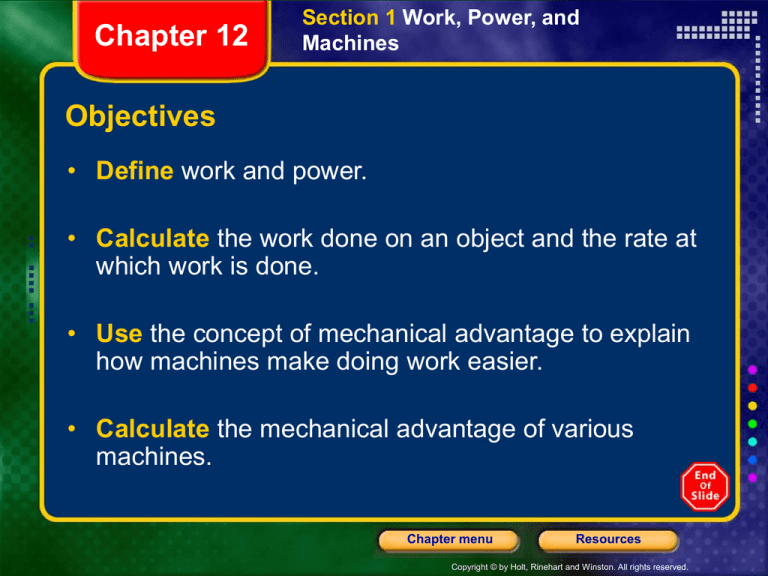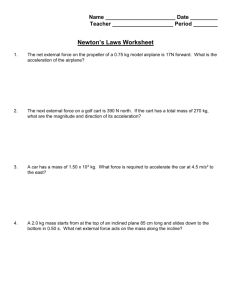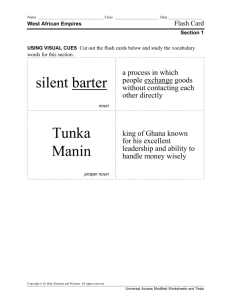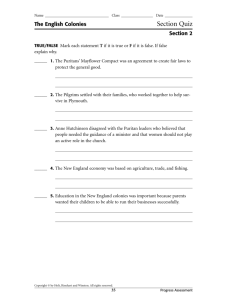
Chapter 12
Section 1 Work, Power, and
Machines
Objectives
• Define work and power.
• Calculate the work done on an object and the rate at
which work is done.
• Use the concept of mechanical advantage to explain
how machines make doing work easier.
• Calculate the mechanical advantage of various
machines.
Chapter menu
Resources
Copyright © by Holt, Rinehart and Winston. All rights reserved.
Chapter 12
Section 1 Work, Power, and
Machines
Bellringer
In your study of motion, you have learned that forces
can cause motion. But in some cases, a force that is
applied is balanced by another opposite force, and
there is no net motion as a result. Look at the following
illustrations, and identify the forces and motion in each
one. (See illustrations on following slide.)
1. In one drawing, no motion is likely to occur. Which
drawing is it?
2. Describe the forces that are acting in this diagram. If
the person exerts slightly more force, what happens to
the opposite force? Does it increase to match the new
force of the person, stay the same, or decrease?
Chapter menu
Resources
Copyright © by Holt, Rinehart and Winston. All rights reserved.
Chapter 12
Section 1 Work, Power, and
Machines
Bellringer, continued
Chapter menu
Resources
Copyright © by Holt, Rinehart and Winston. All rights reserved.
Chapter 12
Section 1 Work, Power, and
Machines
What is Work?
• Work is the transfer of energy to a body by the
application of a force that causes the body to move in
the direction of the force.
• Work is done only when a force causes an object to
move in the direction of the force. This is different
from the everyday meaning of work.
• Work Equation
work = force distance
W=Fd
Chapter menu
Resources
Copyright © by Holt, Rinehart and Winston. All rights reserved.
Chapter 12
Section 1 Work, Power, and
Machines
What is Work?, continued
• Work is measured in joules.
• Because work is calculated as force times
distance, it is measured in units of newtons times
meters, N•m.
• These units are also called joules (J). In terms of
SI base units, a joule is equivalent to 1 kg•m2/s2.
• Definition of joules
1 J = 1 N•m = 1 kg•m2/s2
Chapter menu
Resources
Copyright © by Holt, Rinehart and Winston. All rights reserved.
Chapter 12
Section 1 Work, Power, and
Machines
Math Skills
Work Imagine a father playing with his daughter by
lifting her repeatedly in the air. How much work does
he do with each lift, assuming he lifts her 2.0 m and
exerts an average force of 190 N?
1. List the given and unknown values.
Given:
Unknown:
force, F = 190 N
distance, d = 2.0 m
work, W = ? J
Chapter menu
Resources
Copyright © by Holt, Rinehart and Winston. All rights reserved.
Chapter 12
Section 1 Work, Power, and
Machines
Math Skills, continued
2. Write the equation for work.
work = force distance
W=f d
3. Insert the known values into the equation, and
solve.
W = 190 N 2.0 m = 380 N•m
W = 380 J
Chapter menu
Resources
Copyright © by Holt, Rinehart and Winston. All rights reserved.
Chapter 12
Section 1 Work, Power, and
Machines
Power
• Power is a quantity that measures the rate at which
work is done or energy is transformed.
• Power Equation
work
power
time
W
P
t
• Power is measured in watts.
• A watt (W) is equal to a joule per second (1 J/s).
Chapter menu
Resources
Copyright © by Holt, Rinehart and Winston. All rights reserved.
Chapter 12
Section 1 Work, Power, and
Machines
Math Skills
Power It takes 100 kJ of work to lift an elevator 18 m. If
this is done in 20 s, what is the average power of the
elevator during the process?
1. List the given and unknown values.
Given:
work, W = 100 kJ = 1 105 J
time, t = 20 s
The distance of 18 m will not be needed to
calculate power.
Unknown: power, P = ? W
Chapter menu
Resources
Copyright © by Holt, Rinehart and Winston. All rights reserved.
Chapter 12
Section 1 Work, Power, and
Machines
Math Skills, continued
2. Write the equation for power.
work
power
time
W
P
t
3. Insert the known values into the equation, and
solve.
1 105 J
P
5 103 J/s
20 s
P 5 103 W 5 kW
Chapter menu
Resources
Copyright © by Holt, Rinehart and Winston. All rights reserved.
Chapter 12
Section 1 Work, Power, and
Machines
Machines and Mechanical Advantage
• Machines multiply and redirect forces.
• Machines help people by redistributing the work
put into them.
• They can change either the size or the direction of
the input force.
• Different forces can do the same amount of work.
• A machine allows the same amount of work to be
done by either decreasing the distance while
increasing the force or by decreasing the force
while increasing the distance.
Chapter menu
Resources
Copyright © by Holt, Rinehart and Winston. All rights reserved.
Chapter 12
Section 1 Work, Power, and
Machines
Force and Work
Chapter menu
Resources
Copyright © by Holt, Rinehart and Winston. All rights reserved.
Chapter 12
Section 1 Work, Power, and
Machines
Machines and Mechanical Advantage, continued
• Mechanical advantage tells how much a machine
multiplies force or increases distance.
• Mechanical Advantage Equation
mechanical advantage
output force input distance
input force output distance
Chapter menu
Resources
Copyright © by Holt, Rinehart and Winston. All rights reserved.
Chapter 12
Section 1 Work, Power, and
Machines
Math Skills
Mechanical Advantage Calculate the mechanical
advantage of a ramp that is 5.0 m long and 1.5 m
high.
1. List the given and unknown values.
Given:
input distance = 5.0 m
output distance = 1.5 m
Unknown:
mechanical advantage = ?
Chapter menu
Resources
Copyright © by Holt, Rinehart and Winston. All rights reserved.
Chapter 12
Section 1 Work, Power, and
Machines
Math Skills, continued
2. Write the equation for mechanical advantage.
Because the information we are given involves
only distance, we only need part of the full
equation:
input distance
mechanical advantage
output distance
3. Insert the known values into the equation, and
solve.
5.0 m
mechanical advantage
3.3
1.5 m
Chapter menu
Resources
Copyright © by Holt, Rinehart and Winston. All rights reserved.
Chapter 12
Section 2 Simple Machines
Objectives
• Name and describe the six types of simple machines.
• Discuss the mechanical advantage of different types
of simple machines.
• Recognize simple machines within compound
machines.
Chapter menu
Resources
Copyright © by Holt, Rinehart and Winston. All rights reserved.
Chapter 12
Section 2 Simple Machines
The Lever Family
• The most basic machines are called simple
machines.
• The six types of simple machines are divided into two
families.
The lever family:
The inclined plane family:
• simple lever
• simple inclined plane
• pulley
• wedge
• wheel and axle
• screw
Chapter menu
Resources
Copyright © by Holt, Rinehart and Winston. All rights reserved.
Chapter 12
Section 2 Simple Machines
The Lever Family, continued
• Levers have a rigid arm and a fulcrum.
• Levers are divided into three classes.
• All first-class levers have a fulcrum located
between the points of application of the input and
output forces.
• In a second-class lever, the fulcrum is at one end
of the arm and the input force is applied to the
other end.
• Third-class levers multiply distance rather than
force. As a result, they have a mechanical
advantage of less than 1.
Chapter menu
Resources
Copyright © by Holt, Rinehart and Winston. All rights reserved.
Chapter 12
Section 2 Simple Machines
Levers
Chapter menu
Resources
Copyright © by Holt, Rinehart and Winston. All rights reserved.
Chapter 12
Section 2 Simple Machines
The Lever Family, continued
• Pulleys are modified levers.
• The point in the middle of a pulley is like the
fulcrum of a lever.
• A single, fixed pulley has a mechanical advantage
of 1.
• Multiple pulleys are sometimes put together in a
single unit called a block and tackle.
• A wheel and axle is a lever or pulley connected to a
shaft.
• The steering wheel of a car, screwdrivers, and
cranks are common wheel-and-axel machines.
Chapter menu
Resources
Copyright © by Holt, Rinehart and Winston. All rights reserved.
Chapter 12
Section 2 Simple Machines
Pulleys
Chapter menu
Resources
Copyright © by Holt, Rinehart and Winston. All rights reserved.
Chapter 12
Section 2 Simple Machines
The Inclined Plane Family
• Inclined planes multiply and redirect force.
• An inclined plane turns a small input force into a
large output force by spreading the work out over
a large distance.
• A wedge is a modified inclined plane.
• A screw is an inclined plane wrapped around a
cylinder.
Chapter menu
Resources
Copyright © by Holt, Rinehart and Winston. All rights reserved.
Chapter 12
Section 2 Simple Machines
Compound Machines
• A machine made of more than one simple machine is
called a compound machine.
• Examples of compound machines are:
• scissors, which use two first class levers joined at
a common fulcrum
• a car jack, which uses a lever in combination with
a large screw
Chapter menu
Resources
Copyright © by Holt, Rinehart and Winston. All rights reserved.
Chapter 12
Section 4 Conservation of
Energy
Objectives
• Analyze the efficiency of machines.
Chapter menu
Resources
Copyright © by Holt, Rinehart and Winston. All rights reserved.
Chapter 12
Section 4 Conservation of
Energy
Efficiency of Machines
• Not all of the work done by a machine is useful work.
• A machine cannot do more work than the work
required to operate the machine.
• Because of friction, the work output of a machine
is always somewhat less than the work input.
• Efficiency is the ratio of useful work out to work in.
• Efficiency is usually expressed as a percentage.
• The efficiency of a machine is a measure of how
much useful work it can do.
Chapter menu
Resources
Copyright © by Holt, Rinehart and Winston. All rights reserved.
Chapter 12
Section 4 Conservation of
Energy
Efficiency of Machines, continued
• Efficiency Equation
efficiency
useful work output
work input
• Perpetual motion machines are impossible.
• Energy is always lost to friction or air resistance.
• Machines need energy input.
• Because energy always leaks out of a system,
every machine needs at least a small amount of
energy input to keep going.
Chapter menu
Resources
Copyright © by Holt, Rinehart and Winston. All rights reserved.
Chapter 12
Section 4 Conservation of
Energy
Math Skills
Efficiency A sailor uses a rope and an old, squeaky
pulley to raise a sail that weighs 140 N. He finds that
he must do 180 J of work on the rope in order to raise
the sail by 1 m (doing 140 J of work on the sail).
What is the efficiency of the pulley? Express your
answer as a percentage.
1. List the given and unknown values.
Given:
work input = 180 J
useful work output = 140 J
Unknown: efficiency = ? %
Chapter menu
Resources
Copyright © by Holt, Rinehart and Winston. All rights reserved.
Chapter 12
Section 4 Conservation of
Energy
Math Skills, continued
2. Write the equation for efficiency.
useful work output
efficiency
work input
3. Insert the known values into the equation, and
solve.
140 J
efficiency
0.78
180 J
To express this as a percentage, multiply by 100
and add the percent sign, "%."
efficiency 0.78 100% 78%
Chapter menu
Resources
Copyright © by Holt, Rinehart and Winston. All rights reserved.
Chapter 12
Standardized Test Prep
Understanding Concepts, continued
4. A coal-burning power plant produces electrical
energy with an efficiency of 30%. If the chemical
energy produced by burning one kilogram of coal is
25,000,000 joules (J), how many joules of electrical
energy are produced by the combustion of one gram
of coal?
Answer: 7500 J
Chapter menu
Resources
Copyright © by Holt, Rinehart and Winston. All rights reserved.
Chapter 12
Standardized Test Prep
Interpreting Graphics, continued
6. If the input force on this
pulley system is 100 N,
what is the output
force?
F.
G.
H.
I.
100 N
200 N
300 N
400 N
Chapter menu
Resources
Copyright © by Holt, Rinehart and Winston. All rights reserved.
Chapter 12
Standardized Test Prep
Interpreting Graphics, continued
7. How could the amount of
force required to raise the
bucket be decreased even
more?
A. Add additional pulleys.
B. Increase the length of
the rope.
C. Thread the rope
through the pulleys in
opposite order.
D. Increase the amount
of force on the free
end of the rope.
Chapter menu
Resources
Copyright © by Holt, Rinehart and Winston. All rights reserved.









